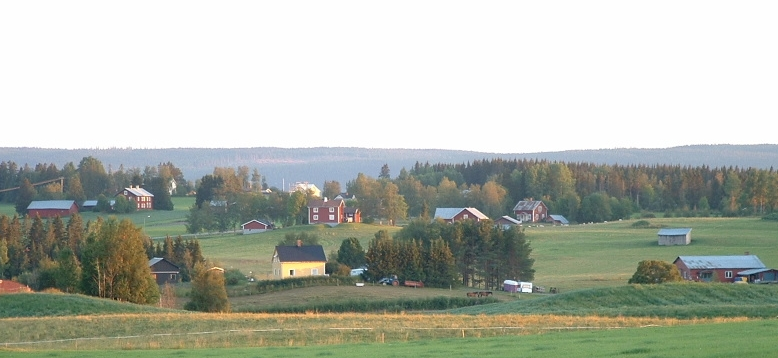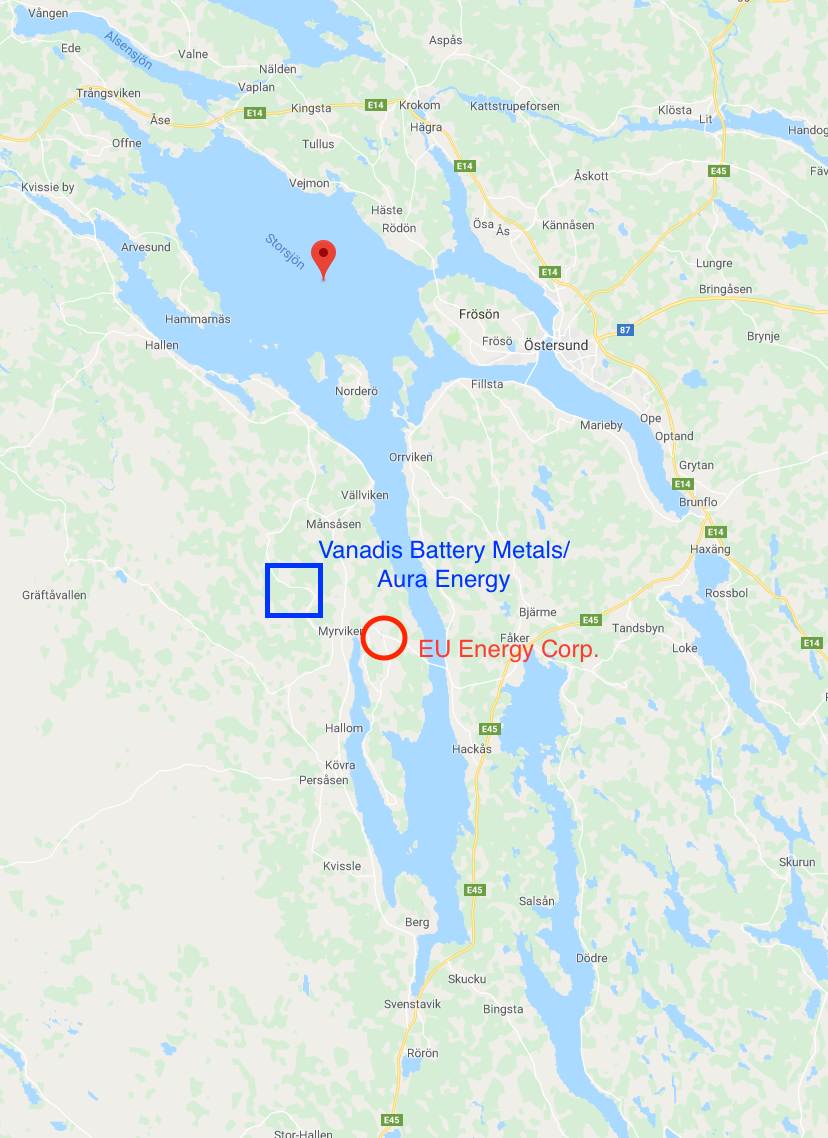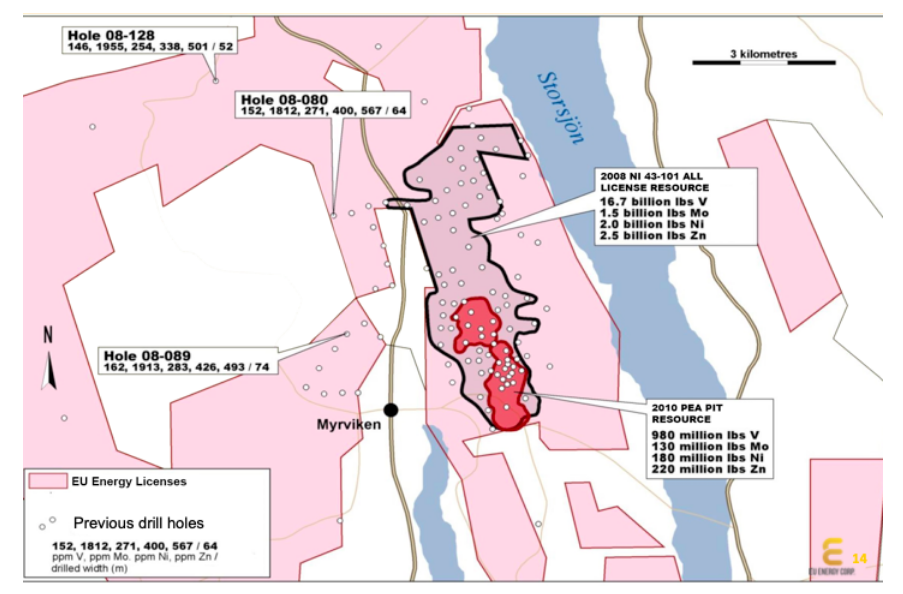Given the information gained from studying SGU’s 28 deep drill cores from around Myrviken in Jämtland, it is of no surprise, that Continental Precious laid their eyes on the Jämtland Alum shale and applied for exploration permits already in 2005 for the sites Hackåsen, Viken, Kämpdalen, Bölåsen and Åbbåsen. From then on, things moved fast. Already 2007, a new player showed up, Vanadis Battery Metals AB, who gained licenses for Häggån 1; and in 2008 Continental Precious obtained licenses for Hackåsen 2 and Vattjom and in the year 2016 Canada-based EU Energy Corp. took over the licenses that had been granted to Continental Precious. Confusing? Yes!

Photo credit: Toggan. Downloaded from https://sv.m.wikipedia.org/wiki/Fil:Oviken.jpg
Between 2015 and 2018 several more new exploration licenses were granted: Kinderåsen 1, Bölåsen 1, Skallböle 1 and Möckelåsen 1 to Vanadis Battery Metals AB. And EU Energy Corp.‘s exploration licenses for Hackåsen 2 and Vattjom were extended. Here you can find a map showing all the exploration permits granted for Sweden and once you zoom in on Östersund, you will find those that have been granted for the Storsjö area.
I looked a bit into the applications for obtaining exploration licenses and into the decisions issued by Bergsstaten to understand more about how the whole exploration business in the Storsjö area has evolved.
Continental Precious/EU Energy Corp. gained licenses for molybdenum and vanadium in Åbbåsen, Bölåsenand Hackåsen; for vanadium in Hackåsen 2; and for vanadium, nickel, zinc and uranium in Vattjom. Since it is no longer allowed to mine uranium in Sweden and since vanadium prices were on the rise, focus of the exploration company has shifted to vanadium.
Australian company Aura Energy / Vanadis Battery Metals AB, applied for investigating the Alum shale for its content of molybdenum, nickel, oil and uranium in Häggån 1 and of molybdenum in Kinderåsen 1, Bölåsen 1, Skallböle 1 and Möckelåsen 1. The ban on mining uranium in Sweden, which came into effect 2018, led the company to also shift focus to vanadium.
Exploratory drilling and analyses of the drill cores, the 2018 ban on uranium and the current focus on vanadium for use in redox-flow batteries has led the companies to more closely define the two areas where most of the desired metals can be found:

Downloaded from Google maps
According to EU Energy Corp.‘s web site, the company has already started base line studies for obtaining an exploitation permit for their so-called Viken Project. This means that the company has clear plans for an open-cast mine to extract vanadium within the next three years.

https://www.euenergycorp.com/viken
EU Energy Corp.‘s Mr. Purdy claims that leakage of uranium from the planned mine and the mining waste to the groundwater and to the lake will not occur, because mining will be done in a more sustainable way. Dear Mr. Purdy – please explain what you understand under the terms ‘sustainable’ or ‘more environmentally friendly’ and please explain why your mine should be sustainable. Please also explain exactly how you will avoid that uranium or other toxic elements will leach from your mine’s mining waste. It is not enough to say that this will not happen. You need to prove – in a scientific way – that it will not happen. Unfortunately existing examples of uranium leakage contradict your statement.
In the same interview EU Energy Corp.‘s Mr. Purdy claims that the mine will create around 40 jobs during 15 years. And how many jobs will disappear because of the planned mine? Mr. Purdy also says that the planned mine will be much smaller than the mine that had originally been planned. Maybe someone should calculate what small means in this context. How deep will the mine have to be to extract the amounts of vanadium that are advertised? Where will the processing plant be built? Where will the waste be deposited?
Interestingly, a new company called American Battery Minerals has appeared on the horizon this year. I am citing from their website, “American Battery Metals entered into a non-binding letter of intent (“LOI”) dated April 25th, 2019 to acquire a 90% interest in the Viken project from E.U. Energy Corp., a private Canadian company.” (Website accessed Sept 24, 2019). Let’s see how this will develop.
The other player on the stage, Vanadis Battery Metals has a much more flashy web site compared to EU Energy Corp.. The company now seems to concentrate on their Häggån 1 project, but I have so far not found any information regarding applications for an exploration permit. Vanadis Battery Metals is, by the way, to 100% owned by Aura Energy.

In their June 2018 Quarterly Report, Aura Energy write that they can extract 90 million tonnes of 0.42% grade vanadium pentoxide at Häggån and that 49 million tonnes of the high grade vanadium pentoxide lies between 20 and 100 depth. This would mean that a potential mine could be as deep as 100 m! In an October 25, 2018 update, Aura Energy summarized the drilling program, which included 17 drill holes in 2008, 25 drill holes in 2010, 10 drill holes in 2011, 14 drill holes in 2012, 1 drill hole in 2015 and 2 drill holes in 2017. By now, the Häggån area must look worse than an Emmentaler cheese given the many bore holes that have been made so far.
According to Aura Energy‘s October 2018 update, the estimated vanadium resource covers an area of around 4.4 x 3.4 km and is located between 10 m and 130 m depth, with a maximum at 275 m depth. Samples of the Alum shale were analyzed for their content in vanadium pentoxide and for a range of other metals and minerals. Also different leaching experiments have been performed to understand how most of the vanadium can be extracted. Acid pressure leach proved most successful as it led to 61% vanadium recovery. This method is usually employed to extract other metals, but there is also an increasing number of literature addressing acid pressure leaching experiments to extract vanadium both from, for example, mining slag and shale.
In an update, the company writes in August 2019, that 22 holes with a total of 2930 meters have been drilled and that they have encountered high contents of vanadium pentoxide (0.41-0.45 %) at depths of between 54 and 103 meters. In addition to vanadium, Aura Energy reports high contents of nickel, zinc and molybdenum, as well as of uranium. Should they plan on extracting the whole resource, then the mine will be pretty deep and the amount of mining waste will be gigantic.


Hi Barbara. Great article from two and a half years ago, thank you, but what’s the current position re exploitation of these various resources? Sweden is serious about clean energy and EV’s so the economic attraction and demand for native battery metals and even uranium gets ever stronger. Will Sweden approve their extraction? Kind regards, Eric.